How to Attract and Identify a Purple Finch
Updated: Mar. 29, 2022
Attracting a purple finch is easy with the right food, but identifying one can be tricky! Here's how to spot these colorful finches.
Purple finches are an absolute backyard treat but, despite their vivid-sounding name, their subdued pattern can make them difficult to spot. Roger Tory Peterson, the ornithologist and editor of the Peterson Field Guide series, once described a purple finch as a “sparrow dipped in raspberry juice.”
Don’t miss these super pretty pictures of finches.
What Does a Purple Finch Look Like?
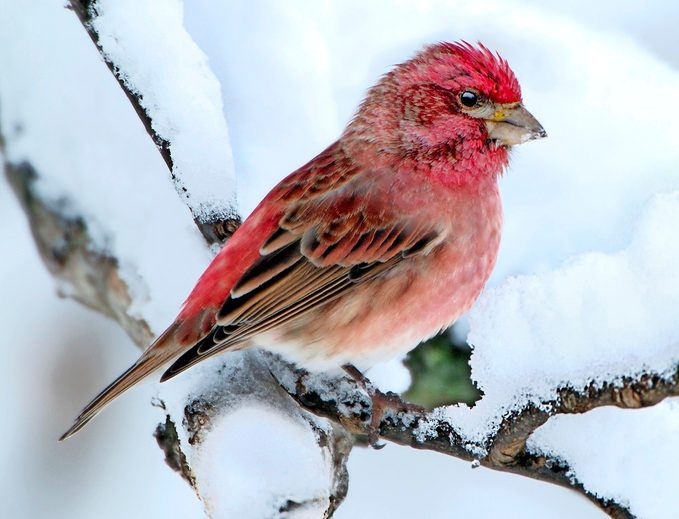
Birding experts Kenn and Kimberly Kaufman say, “Even with its beautiful raspberry tones, the adult male purple finch can be a challenge to identify. In eastern North America, the most similar bird is the male house finch. For a quick field mark, we’d look at the area of the flanks, under the wing. A house finch will always show some thick brown streaks there, whereas the purple finch is mottled with rose red. The purple finch also has a thicker bill, rounder body and shorter tail than the house finch. These key differences can be very helpful for separating the two species at a glance.”
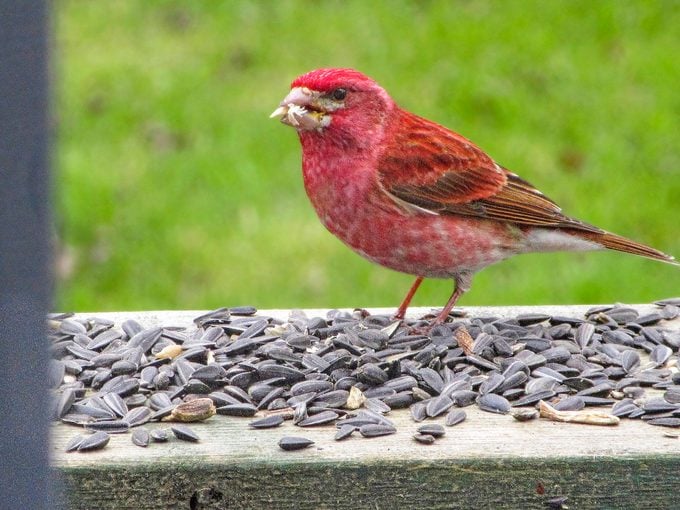
Male purple finches have an almost completely red face and neck with pinkish red also covering most of the body. Purple finches and house finches don’t flock together, but they might both show up at your feeder at the same time. Look for a bird that’s slightly larger than a chickadee or nuthatch, has a short notched tail and a prominent, strong beak, which they mainly use to crack into tough seeds.
In late summer, the purple finch begins to molt, and in winter plumage, a male’s reddish areas appear frosted. With wear, the whitish tinge disappears, revealing the rich breeding color.
In the West, Cassin’s finches also present an identification hurdle. They have a bright red cap, like the purple finch, but a lighter pink face, neck and upper chest.
Scientific Name: Haemorhous purpureus
Family: Finch
Length: 6 inches
Wingspan: 10 inches
Distinctive Markings: Male has a raspberry-red tinge, brightest on head and rump; lighter in winter. Notched tail. Female is brown-gray striped, with a dark cheek patch.
Discover 7 types of finch birds to look for in winter.
What Do Purple Finches Eat?

Black oil sunflower seeds seem to be the food of choice for purple finches, but they also eat white millet and thistle seeds. They also feed on buds, berries, and insects.
Check out the best finch feeders to serve thistle seed.
Purple Finch Song
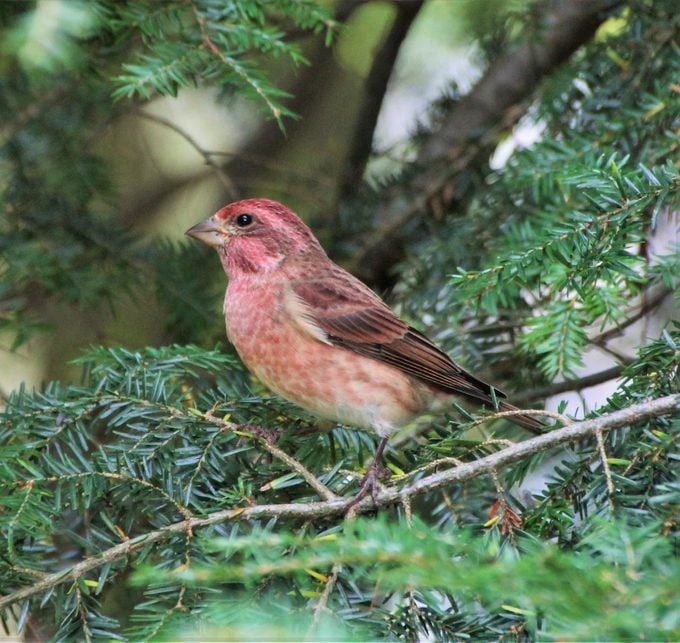
Listen to the purple finch’s song. This bird sings and unstructured but melodious “fridi ferdi frididifri fridi frr” song.
Bird songs provided by the Cornell Lab of Ornithology.
A musical bird, the purple finch sometimes copies other birds, such as American goldfinches or eastern towhees, as they sing loudly from the treetops. But when it’s time to woo a mate, the male purple finch mellows his tune, hopping in front of the female and puffing his feathers. If she’s interested, the avian Romeo pops a foot in the air, vibrates his wings and then lands, presenting a twig or piece of grass.
Meet the rosy finch (and learn the best place to see one).
Purple Finch Nest and Eggs
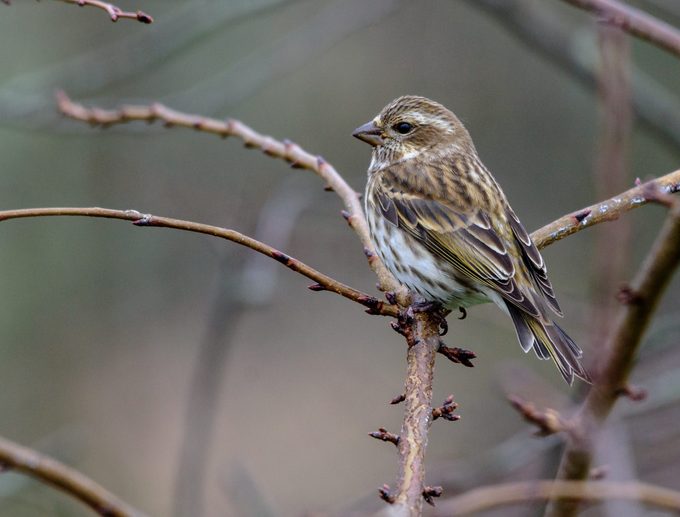
Purple finches like to nest on the limbs of conifers, though in the southern part of their breeding range they might nest in an oak, maple or cherry tree. The female carefully builds a twig cup, about 7 inches across and 4 inches deep, lining it with grass, moss and animal fur in preparation for the young.
Clutches range from two to seven pale blue-green eggs with brown and black marks, each just under an inch long. It takes less than two weeks for the eggs to hatch. Afterward, both parents feed the naked, helpless chicks. The young grow quickly and fledge in another two weeks.
Watch your feeders in winter for a common redpoll.
Purple Finch Habitat and Range Map
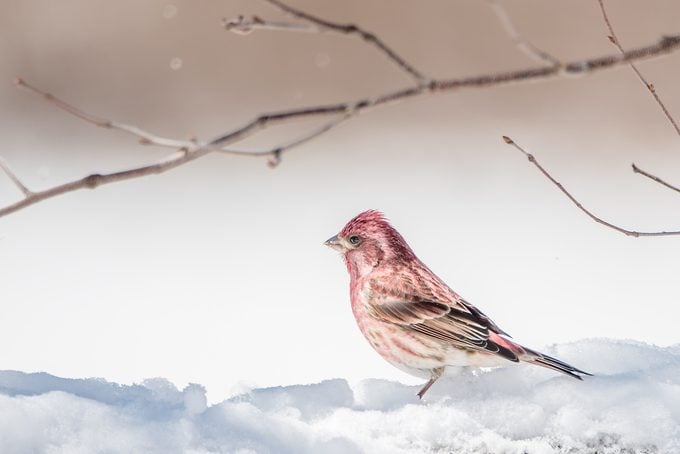
These forest-dwelling songbirds are found mainly in the Midwest, East and along the Pacific Coast. Don’t worry if these colorful finches came to your backyard last winter but don’t show up this year. They migrate erratically. Those that breed in Canada head to the central and southern United States for the winter, while the ones that spend their summer on the Pacific Coast, around the Great Lakes and in the Northeast often don’t migrate at all, except perhaps to lower elevations. They’ll probably be back again, especially if your feeders are filled with black oil sunflower seeds. For more advice, see our tips to attract winter birds. These birds may show up in coniferous and mixed forest, oak woodlands, parks, streamsides and residential areas.
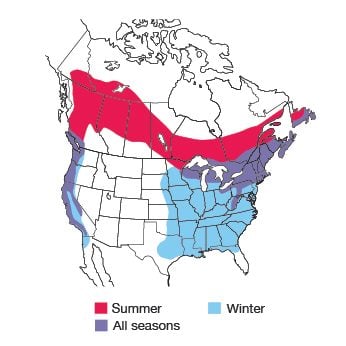
Range maps provided by Kaufman Field Guides, the official field guide of Birds & Blooms.
Next, learn how to attract goldfinches to your backyard.




















